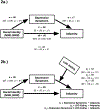Negative affect and loss-of-control eating in relation to adiposity among non-Hispanic youth identifying as black or white
- PMID: 36989932
- PMCID: PMC10239321
- DOI: 10.1016/j.eatbeh.2023.101721
Negative affect and loss-of-control eating in relation to adiposity among non-Hispanic youth identifying as black or white
Abstract
Negative affect and loss-of-control (LOC)-eating are consistently linked and prevalent among youth identifying as non-Hispanic Black (NHB) and non-Hispanic White (NHW), particularly those with high weight. Given health disparities in high weight and associated cardiometabolic health concerns among NHB youth, elucidating how the association of negative affect with adiposity may vary by racial/ethnic group, and whether that relationship is impacted by LOC-eating, is warranted. Social inequities and related stressors are associated with negative affect among NHB youth, which may place this group at increased risk for excess weight gain. Across multiple aggregated protocols, 651 youth (13.0 ± 2.7 y; 65.9 % girls, 40.7 % NHB; 1.0 ± 1.1 BMIz; 37.6 % LOC-eating) self-reported trait anxiety and depressive symptoms as facets of negative affect. LOC-eating was assessed by interview and adiposity was measured objectively. Cross-sectional moderated mediation models predicted adiposity from ethno-racial identification (NHB, NHW) through the pathway of anxiety or depressive symptoms and examined whether LOC-eating influenced the strength of the pathway, adjusting for SES, age, height, and sex. The association between ethno-racial identity and adiposity was partially mediated by both anxiety (95 % CI = [0.01, 0.05]) and depressive symptoms (95 % CI = [0.02, 0.08]), but the mediation was not moderated by LOC-eating for either anxiety (95 % CI = [-0.04, 0.003]) or depressive symptoms (95 % CI = [-0.07, 0.03]). Mechanisms underlying the link between negative affect and adiposity among NHB youth, such as stress from discrimination and stress-related inflammation, should be explored. These data highlight the need to study impacts of social inequities on psychosocial and health outcomes.
Keywords: Adiposity; Ethno-racial identity; Loss-of-control eating; Negative affect; Sociocultural factors.
Copyright © 2023 Elsevier Ltd. All rights reserved.
Conflict of interest statement
Declaration of competing interest None.
Figures


Similar articles
-
Pediatric Loss-of-Control Eating and Anxiety in Relation to Components of Metabolic Syndrome.J Pediatr Psychol. 2019 Mar 1;44(2):220-228. doi: 10.1093/jpepsy/jsy077. J Pediatr Psychol. 2019. PMID: 30339233 Free PMC article.
-
Relationships of Trait Anxiety and Loss of Control Eating with Serum Leptin Concentrations among Youth.Nutrients. 2019 Sep 12;11(9):2198. doi: 10.3390/nu11092198. Nutrients. 2019. PMID: 31547319 Free PMC article.
-
Associations between weight-based teasing and disordered eating behaviors among youth.Eat Behav. 2021 Apr;41:101504. doi: 10.1016/j.eatbeh.2021.101504. Epub 2021 Mar 29. Eat Behav. 2021. PMID: 33831812 Free PMC article.
-
Loss-of-Control Eating and Cardiometabolic Health in Relation to Overweight and Obesity.Curr Diab Rep. 2022 Jun;22(6):257-266. doi: 10.1007/s11892-022-01466-z. Epub 2022 Apr 11. Curr Diab Rep. 2022. PMID: 35403985 Review.
-
Loss-of-Control Eating and Obesity Among Children and Adolescents.Curr Obes Rep. 2019 Mar;8(1):33-42. doi: 10.1007/s13679-019-0327-1. Curr Obes Rep. 2019. PMID: 30701372 Review.
References
-
- American Medical Association. (2020). Elimination of race as a proxy for ancestry, genetics, and biology in medical education, research and clinical practice H-65.953: a policy statement American Medical Association. Retrieved November, 2022 from https://policysearch.ama-assn.org/policyfinder/detail/race?uri=%2FAMADoc...
-
- American Psychiatric Association. (2022). Diagnostic and statistical manual of mental disorders, Fifth edition, text revision (DSM-5-TR) (5th ed.). American Psychiatric Association.
-
- Brody GH, Chen YF, Murry VM, Ge X, Simons RL, Gibbons FX, Gerrard M, & Cutrona CE (2006). Perceived discrimination and the adjustment of African American youths: A five-year longitudinal analysis with contextual moderation effects. Child Development, 77(5), 1170–1189. - PubMed
-
- Brown MT, & Duren PS (1988). Construct validity for blacks of the state-trait anxiety inventory. Measurement and Evaluation in Counseling and Development, 21(1), 25–33.
Publication types
MeSH terms
Grants and funding
LinkOut - more resources
Full Text Sources

